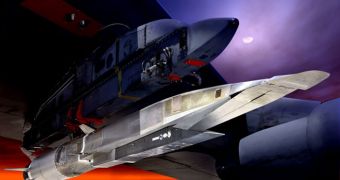Creating a viable and efficient scramjet engine is not something that can be done easily. Experts from numerous countries have been working for decades on getting working prototypes up and running, but thus far most of their attempts have failed. Apparently, scientists in the United States managed to nail it, as the Pentagon is currently getting ready to begin the long-duration flights of the X-51, the first hypersonic, scramjet-powered aircraft in the world. If successful, the US will gain “Prompt Global Strike” capability, which means that it will be able to hit any target in the world faster than ever before, Space reports.
What the new aircraft does is to basically tie atmospheric and space propulsion together, and make them accessible to a single engine. Scramjet engines have a fairly simple propulsion system, but which is extremely difficult to create in practice. Aircrafts employing them are generally designed in such a manner that they are able to make their own shock waves go directly into their engine's inlets. In other words, they no longer actively absorb air into the combustion chamber, but rather “model” it in through their shape. This allows scramjet aircraft to reach speeds of up to Mach 15, and to go as high as the edge of space, where the atmosphere ends.
This type of “breathing propulsion” also holds great promise for promoting the field of space exploration. Most experts agree that relying on chemical fuels such as liquid hydrogen and liquid oxygen for rocket launches will not always be possible. Therefore, replacing these systems with scramjets could prove to be a viable alternative. US President Barack Obama is a strong support for this avenue of research, and he proposed an additional $200 million in funding for the 2011 fiscal year, to encourage progress. American officials report that the new tests will begin as early as May 25, 2010.
The goal of scramjet efforts “is to enable the ability to get to space, return to Earth, then get back to space with an aircraft-like operations tempo,” reads the Hypersonic Roadmap, a formal strategy of the Pentagon. The document is in charge of governing and regulating the growing number of scramjet-related projects that are currently in the works. NASA and various branches of the US military are involved in such work. The X-51 Waverider that will begin testing soon is built by the US Air Force, the Defense Advanced Research Projects Agency (DARPA), NASA, Boeing Phantom Works, and Pratt & Whitney. Flights will take place from the Edwards Air Force Base (EAFB), in California.

 14 DAY TRIAL //
14 DAY TRIAL //